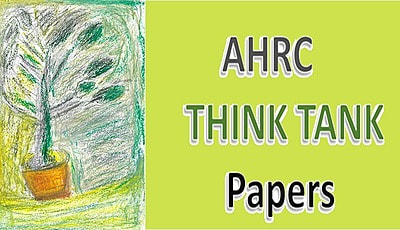Executive Summary
- Contents
-
- Key Findings of the Evaluation (I):
- Key Findings (II): Achievements vis-à-vis intended results
- Key Findings (III): Assessment of Outcome
- Key Findings (IV): Outcome attributed to the project
- Key Findings (V): Conclusions on the outcome of the project
- Key Findings (VI): Assessment of preventive strategies
- 10 Key Recommendations
This report contains the findings of the Final Evaluation of the ‘Prevention of Police Torture Project’ in Sri Lanka.
The overall goal of the project ‘Prevention of Police Torture in Sri Lanka’ was to achieve breakthroughs in terms of attitude, policy, legislative changes and changes in the institutional practices of relevant government agencies in Sri Lanka.
Key Findings of the Evaluation (I):
The project is relevant, effective, and there are reasons to believe that it has sustainable impact.
The AHRC model is unique in several ways:
1. as an integrated approach to torture combining service delivery and advocacy at grassroots level with high profile advocacy at regional and international levels;
2. the AHRC model combines four interrelated areas: advocacy, legal redress, rehabilitation and protection;
3. the project uses a human rights based approach;
4. it addresses torture as a poverty issue.
Key Findings (II): Achievements vis-à-vis intended results
The results of the ‘Prevention of Police Torture Project’ are impressive. It is fair to say that few organisations would, with limited means, reach a similar level of effectiveness.
Key Findings (III): Assessment of Outcome
The evaluation identified several outcomes that can be attributed to the project.
A major outcome is that “Torture is increasingly widely and publicly acknowledged in Sri Lanka”.
The evaluation conducted a detailed assessment of this outcome to create credible linkages between the outcome and the project interventions while accounting for other contextual factors. The evaluation concluded that this outcome can indeed be significantly attributed to the efforts of the AHRC and its partners.
Key Findings (IV): Outcome attributed to the project
The evaluation identified twenty-five (25) different outcomes that can be attributed to the project. The main outcomes are:
- The success of five court cases establishes the usefulness of the CAT Act as a tool to highlight the practice of police torture.
- A Rapid Response Mechanism is in place.
- Six UN Rapporteurs recognise torture as an endemic rule of law problem.
- New pathways in the UN Human Rights Committee.
- Increased EU pressure to the GoSL regarding Human Rights Violations.
- Grassroots participation for knowledge generation, legal redress, pressure to GoSL, victim’s protection and empowerment.
- Tools for an integrated approach to torture, including electronic media.
- Strengthening of the debate on root causes of torture; poverty being a root cause.
- A pool of knowledgeable and skilled staff within the partner organisations.
- At individual level: Awareness, Care, Healing, Justice and Empowerment.
These outcomes can be significantly attributed to the work of the AHRC and its partners within the RCT supported project on ‘Prevention of Police Torture in Sri Lanka’.
Key Findings (V): Conclusions on the outcome of the project
The overall expected outcome of “a systemic breakthrough” on torture prevention has only been achieved to a certain extent. This can not be exclusively attributed to the project, as a closer analysis of the context in which the project operated shows that the project faced a huge number of ‘hindering factors’.
However a great number of significant positive outcomes were definitely realised and these can be directly, or to a considerable extent, attributed to the work of the AHRC.
These outcomes cannot be underestimated. They may well be significant pillars for human rights advocacy in the post-conflict era.
Key Findings (VI): Assessment of preventive strategies
- The relevance of the project is beyond doubt.
- The project is effective and efficient as it made maximum use of the advantages of new technologies. The combination of the 4 AHRC models constitutes keys to effectiveness and efficiency.
- The AHRC’s overall contextual analysis is adequate. Publications substantiating the contextual analysis are relevant, accurate and well documented. Information is validated and verified. The contextual analysis is consistent over time while reflecting contextual changes in the course of the project. There may be a need for an adjustment of the contextual analysis of civil society and a change in the partnership approach.
- There may be a need for specific strategies in view of the special needs of particular vulnerable groups.
- The partners all work with enormous dedication, passion and a boundless sense of responsibility. All have become experts in the field of torture prevention and rehabilitation. All have established victims’ networks and some have created victims’ support groups. All are working under extremely hostile circumstances. The partners all maintain high standards of performance. They all need and deserve support.
- One of the immediate project objectives was “to strengthen the partner network”. The AHRC expected that “a mass-based campaign against torture is now possible”. The “model network of Human Rights activists – People against Torture (PAT)” had formally ceased to exist at the time of the evaluation. The AHRC has been over-optimistic in claiming that it has “successfully created a model network of HR activist organisations” and may perhaps have underestimated the obstacles to reach a common ground between the network partners. The partner network building has been a painful process for partners. There are profound identity issues within the partner network and between the partners and the AHRC. The differences pertain to strategic issues as well as personal/ego-issues. On the other hand, all partners expressed that they are prepared to help revive the partner network.
- The expected “mass-based campaign against torture” has not been realized. This may be partly attributed to the increasingly hostile context in which the project operated. The AHRC and the partners may not have put sufficient effort into bringing about a more inclusive partnership strategy. For an effective revival of the partner network there is a need for a change in the approach to partnership building, and a change in the way the partner network on torture prevention conceives itself within the Sri Lankan human rights movement and civil society at large. This is also a prerequisite for maximizing impact for the project itself.
- The three-tier model has been an appropriate and effective model for the Prevention of Police Torture project. There will have to remain a sound balance between planning and flexibility. Also, the diversity among the partner organisations will have to be respected, as diversity is one of the strengths of the network.
- The project would benefit from integrating a gender perspective at project cycle level and at the organisational level.
- There is no doubt that the victims have a high opinion of the Prevention of Police Torture project. In their perception the AHRC, the partners and RCT have contributed greatly to their empowerment.
- In every project cycle the project has been able to assess lessons learned and incorporate these in the follow up project.
- The project model could be replicated for other organisations working on torture in countries with a similar context.
- The range, intensity, consistency, amount and quality of the technical and financial contributions provided by RCT are remarkable and commendable.
The project has provided new insights in effective approaches to the prevention of torture and rehabilitation of torture victims, in particular in an increasingly hostile context. In that sense the project has contributed to the achievement of RCT’s policy targets for 2015.
10 Key Recommendations
The main recommendations of the evaluation are:
- Healing and therapeutic support need greater attention, programmatic response and further capacity building.
- With the new political situation since May 2009, explore possibilities for covering police torture in the North.
- Integrate a gender perspective at organisational level and at activity level.
- Identify vulnerable groups and special needs,
- The Torture Prevention project would benefit from a clear positioning within the human rights movement in Sri Lanka and civil society at large and a pro-active and inclusive strategy on partnership and alliance building. Including a perspective on the broadest possible civil society platform on torture prevention and human rights and a unified agenda. It would also benefit from the creation of alliances with other organizations with mandates on torture and HR including women’s organizations. This is a requirement for the project to gain maximum impact.
- Strategic Planning: Organise a joint strategic planning, resulting in a common plan. This should include an analysis of civil society and partnership. There should be a redefinition of the strategic partnership.
- Results Based Management: in the future project develop a logframe, undertake monitoring of results vis-à-vis expected results in a systematic way. Capacity Building on results based management for the AHRC and partners.
- Develop and institutionalise a notion of “Caring in the organisation”. Identify needs among management, staff, caretakers and victims.
- Tools for advocacy and campaigning: Diversify ways to get the message across: involve arts, drama, including visual arts as means of communication; expand partnerships with likeminded organisations in the area of culture.
- Write a manual or booklet for organisations working on torture prevention elsewhere in the world, sharing the unique and highly relevant experience from the AHRC and partners. What to do, how to do it. This should including case studies and best practices.



